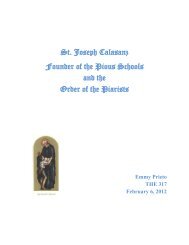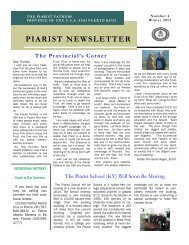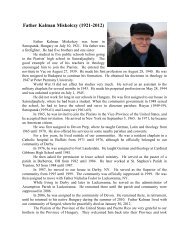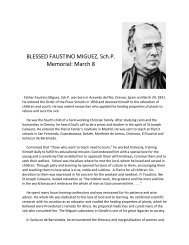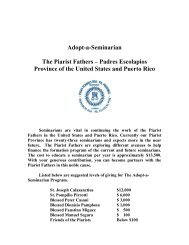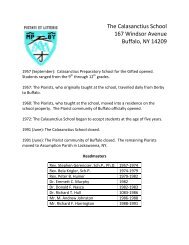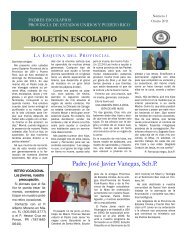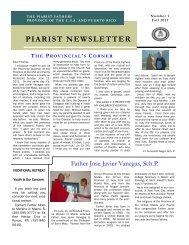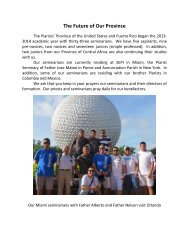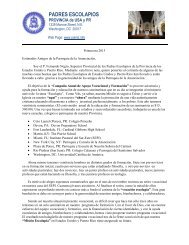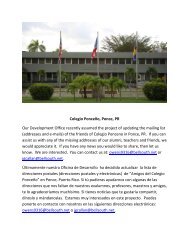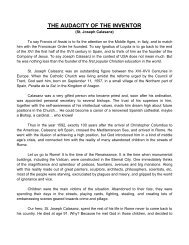Case Statement - The Piarist Fathers
Case Statement - The Piarist Fathers
Case Statement - The Piarist Fathers
Create successful ePaper yourself
Turn your PDF publications into a flip-book with our unique Google optimized e-Paper software.
<strong>Piarist</strong> <strong>Fathers</strong><br />
Province of the United States and Puerto Rico<br />
CASE STATEMENT<br />
I. MISSION STATEMENT<br />
Rooted in the Gospel and inspired by Saint Joseph Calasanz, the mission of the <strong>Piarist</strong><br />
<strong>Fathers</strong> in the United States and Puerto Rico is to follow Christ and to serve the Church<br />
in the multicultural reality, by promoting our unique <strong>Piarist</strong> way of life and by<br />
ministering effectively to the educational needs of children and youth, especially the<br />
poor, so as to empower them to bring about a Christian transformation of our world.<br />
(Revised 6/13/11)<br />
II. GOAL<br />
To provide financial assistance for the formation and education of seminarians, for the<br />
health and well-being of senior members and for the ongoing work of the active<br />
members.<br />
III. OBJECTIVE<br />
To create an integrated development program by initiating new program components and<br />
strengthening existing development efforts in order to raise $350,000 over the next four<br />
years (August 2012 through July 2016).<br />
IV. GOVERNING BOARD<br />
<strong>The</strong> <strong>Piarist</strong> <strong>Fathers</strong>, U.S.A. Province, Inc. is a non-profit corporation with offices in the<br />
District of Columbia.<br />
<strong>The</strong> purposes for which the corporation is organized are:<br />
To engage in, promote and maintain educational, religious and charitable<br />
activities of all kinds consistent with the objectives of the <strong>Piarist</strong> <strong>Fathers</strong>, a<br />
Roman Catholic religious community;<br />
To establish, operate and maintain educational institutions in all fields of<br />
learning;<br />
To minister to the spiritual needs of the laity and to perform all corporal<br />
and spiritual works of mercy.<br />
<strong>The</strong> members of the Board of Directors are any <strong>Piarist</strong> priest, professed seminarian or<br />
novice, who is assigned to any one of the officially established communities of the<br />
Province of the United States and Puerto Rico.<br />
<strong>The</strong> officers of the Board of Directors are the Chairman, President, Vice-President,<br />
Secretary and Treasurer. <strong>The</strong> members of the corporation elect the officers for a term of<br />
one year during the annual meeting of the Board.
<strong>The</strong> Chairman presides at any meetings of the officers and during the annual meeting of<br />
the Board.<br />
<strong>The</strong> President is the chief executive officer of the Corporation, has the responsibility for<br />
the general management of the affairs of the Corporation, and carries out the resolutions<br />
of the Board of Directors.<br />
During the absence or disability of the President of the Corporation, the Vice-President<br />
has all the powers and functions of the President. <strong>The</strong> Vice-President performs such<br />
duties as may be described by the Board of Directors from time to time.<br />
<strong>The</strong> Secretary keeps the minutes of the Officers and the minutes of the Board of<br />
Directors. He has custody of the seal of the Corporation, and affixes and attests the same<br />
documents duly authorized by the Board of Directors. He serves all notices for the<br />
Corporation, which have been authorized by the Board of Directors, and has charge of all<br />
books and records of the Corporation.<br />
<strong>The</strong> Treasurer has the care and custody of all the funds and securities of the Corporation,<br />
and deposits said funds in the name of the Corporation in such bank accounts as the<br />
Board of Directors may from time to time determine. <strong>The</strong> Treasurer, when duly<br />
authorized by the Board of Directors, signs and executes all contracts in the name of the<br />
Corporation when counter-signed by the President; he also signs checks, drafts, notes,<br />
and orders for the payment of money, which have been duly authorized by the Board of<br />
Directors and counter-signed by the President.<br />
<strong>The</strong> Chairman and the Treasurer are authorized to transact any and all business matters<br />
for the Corporation. All financial dealings must adhere to the Statutes of the Economy of<br />
the Province, Canon Law, the Constitutions and Rules of the <strong>Piarist</strong> <strong>Fathers</strong>, the<br />
“Directory of Economic and Financial Management of the Pious Schools” and civil law.<br />
<strong>The</strong> Financial Secretariat is a committee of three or more members. <strong>The</strong>y assist the<br />
Chairman and the Treasurer with their work. One of their primary responsibilities is to<br />
advise the Treasurer in the preparation of the annual budget, which must later be<br />
approved by the Chairman, President and Vice-President.<br />
Each officially established community of the Province of the United States and Puerto<br />
Rico has its own Rector and Treasurer. <strong>The</strong>y cooperate during the year with the<br />
Treasurer of the Corporation in his work.<br />
Every other month, the Treasurer must present to the officers a report of the corporate<br />
finances. On this occasion, the officers ask any pertinent questions and propose<br />
suggestions.<br />
During the annual meeting of the Board of Directors, the Treasurer must present to the<br />
members a report of the corporate finances. <strong>The</strong> members are encouraged to discuss the<br />
report and make suggestions.<br />
2
V. STAFFING<br />
<strong>The</strong> Development Office has three staff members. <strong>The</strong> Director of Development is a paid<br />
full-time employee. He is responsible for coordinating the efforts of the Development<br />
Team. In cooperation with the officers of the Board and the other members of the<br />
Corporation, he prepares and executes the Development Plan. He reports on the activities<br />
of the Development Office to the officers every other month and to the members<br />
annually.<br />
VI. FACILITIES<br />
<strong>The</strong> <strong>Piarist</strong>s of the Province of the United States and Puerto Rico currently work in nine<br />
locations. <strong>The</strong>y are:<br />
Coto Laurel, PR – Colegio Ponceno, a college preparatory school for boys and<br />
girls from Pre-K through the twelfth grade. It is also the residence for the priests<br />
teaching in the school and for two retired priests.<br />
Devon, PA – Devon Preparatory School, a college preparatory school for boys<br />
from the sixth through twelfth grades. It is also a residence for the priests who<br />
teach in the school and for two retired priests.<br />
Fort Lauderdale, FL – Cardinal Gibbons High School, an archdiocesan school for<br />
boys and girls from the ninth through twelfth grades. It is also a residence for the<br />
priests who teach in the school and for one retired priest.<br />
Martin, KY – <strong>The</strong> <strong>Piarist</strong> School, a tuition-free college preparatory school for<br />
boys and girls from the ninth through twelfth grades. It is also a residence for the<br />
priests who teach in the school.<br />
Miami, FL – Southeast Pastoral Institute, an organization of the Catholic Bishops,<br />
which helps to train leaders for Hispanic ministry in the nine southern states. It is<br />
also the residence for the priests working at SEPI, the priests working in<br />
formation at Casa Calasanz and most of the younger seminarians of the Province.<br />
New York City, NY – Annunciation Parish, Annunciation School (Kindergarten<br />
through the 8 th grade) and Calasanz Retreat House. It is also the residence for the<br />
priests who work in the parish and the school and for the theology students of the<br />
Province.<br />
Playa de Ponce, PR – Our Lady of Mount Carmel Parish and School (Pre-K<br />
through the 8 th grade). It is also the residence for the priests who work in the<br />
parish and the school and for the philosophy students of the Province.<br />
San Juan, PR – Parish of the Divine Savior and Colegio Calasanz (Pre-K through<br />
the twelfth grade). It is also the residence for the priests who work in the parish<br />
and the school.<br />
Washington, DC – residence for the Provincial Superior and another priest<br />
working at the Catholic University of America.<br />
In addition to these nine locations, one retired priest lives in nursing homes and some<br />
seminarians live in <strong>Piarist</strong> communities closer to their institutes of learning.<br />
3
VII. FINANCES<br />
<strong>The</strong> Corporation is responsible for providing the funds for the formation and education of<br />
<strong>Piarist</strong> seminarians, for the health and well-being of senior members and for the ongoing<br />
work of active members.<br />
<strong>The</strong> Treasurer of the local communities sends a monthly contribution to the corporate<br />
Treasury based upon the number of full-time and part-time priests assigned to the<br />
community.<br />
Until 2001, the funds from these monthly contributions were adequate enough to pay for<br />
the previously mentioned expenses of the Corporation. Since then, the Province has been<br />
blessed with an increasing number of seminarians. At the same time, the ratio of active<br />
priests to retired priests has decreased. As a result, the Corporation has experienced a<br />
deficit for the past few years.<br />
In June 2005, based upon the advice of the Treasurer General of the <strong>Piarist</strong> <strong>Fathers</strong>, the<br />
officers of the Corporation decided to ask for a special contribution from each local<br />
community in order to erase the deficit. <strong>The</strong>refore, the local communities began to<br />
provide the Corporation with the funds to erase the annual deficit.<br />
During the annual meeting of the Corporation in June 2005, the officers explained to the<br />
members that such a measure could only be temporary. <strong>The</strong> local communities could<br />
only provide funds to erase the annual deficit for so long. <strong>The</strong>refore, the officers strongly<br />
urged the Board of Directors to consider establishing a Development Office. <strong>The</strong> Board<br />
accepted the motion.<br />
In 2005, the Board began searching for a Development Director. During the search, Mr.<br />
Mario Arango, a Cuban <strong>Piarist</strong> alumnus, volunteered his services as a part-time Assistant<br />
Development Director. Together with his wife, Teresita, who volunteers her services as<br />
his executive secretary, they solicited contributions from the Cuban <strong>Piarist</strong> alumni and<br />
friends.<br />
In May 2007, the officers hired Mr. Kevin Owens to serve as a paid, full-time Director of<br />
Development. He is a member of the Development Team, together with the officers of<br />
the Corporation and all of its members. It is the hope of the Corporation that the<br />
combined work of the Development Team will be able to provide the funds and resources<br />
necessary for the <strong>Piarist</strong>s of the Province to continue their ministry long into the future.<br />
<strong>The</strong> office raised $55,505 in its first year of operation from August 2007 through July<br />
2008 and raised $97,126 in the most recent fiscal year from August 2010 through July<br />
2011.<br />
4
VIII. PLANNING and EVALUATION<br />
<strong>The</strong> Chairman, President and Vice-President meet every other month. During their<br />
meeting, they discuss the current state of the <strong>Piarist</strong>s in the Province of the United States<br />
and Puerto Rico. Among other issues they discuss the following:<br />
Formation and education of the seminarians<br />
Health and well-being of the senior members<br />
Ministry in the <strong>Piarist</strong>-related works<br />
Cooperation with other regions of the <strong>Piarist</strong> <strong>Fathers</strong> worldwide<br />
Finances<br />
Development Office<br />
<strong>The</strong> members of the Board of Directors meet annually. During the assembly, the<br />
members participate in a retreat, examine the current state of the Province, evaluate the<br />
past year’s programs and activities, and make plans for the future.<br />
<strong>The</strong> Superiors of each region of the Order, of each region of the Americas and of each<br />
region of the North American Sector meet one another at pre-determined intervals. <strong>The</strong>y<br />
discuss issues of common concern and make plans and suggestions for the future.<br />
<strong>The</strong> Treasurer General of the <strong>Piarist</strong> <strong>Fathers</strong> occasionally meets with the Treasurer of<br />
each region. He approves the annual budget, reviews the Annual Report of the Treasury,<br />
and makes plans and suggestions for the future.<br />
<strong>The</strong> Superior General or his delegate occasionally meets with the Vocation Directors and<br />
Formation Directors of each region. <strong>The</strong>y discuss common issues and make plans and<br />
suggestions for the future.<br />
<strong>The</strong> Superior General and an Assistant General of the <strong>Piarist</strong> <strong>Fathers</strong> visit all of the local<br />
communities of the Province of the United States and Puerto Rico at pre-determined<br />
intervals. <strong>The</strong>y examine the state of the Province and make plans and suggestions for the<br />
future.<br />
IX. HISTORY<br />
<strong>The</strong> Founder<br />
St. Joseph Calasanctius (Calasanz) was born in Peralta de la Sal, Spain in 1557. He was<br />
ordained as a priest for the Diocese of Urgel in 1583. Hoping to advance within the<br />
hierarchy, he moved to Rome nine years later.<br />
Shortly after arriving in Rome, he drastically changed the direction in his life when he<br />
recognized the terrible plight of the poor in that city. At first, he taught religion on<br />
weekends with the followers of St. Philip Neri. Soon, however, he realized that weekly<br />
classes in religion were not sufficient. <strong>The</strong>refore, he opened a school at the Church of St.<br />
Dorothy in 1597. This school was the first tuition-free school in modern Europe, a<br />
5
school that was open to all children. Soon, the popularity of his school became so<br />
widespread that he felt the need to open other similar schools.<br />
At the request of St. Joseph Calasanctius, Pope Paul V officially established the Order of<br />
the Pious Schools (<strong>Piarist</strong> <strong>Fathers</strong>) in 1617. Members of the Order take the usual three<br />
vows of poverty, chastity and obedience and a special fourth vow to educate youth,<br />
especially the poor.<br />
Pope Clement XIII canonized St. Joseph Calasanctius in 1767, and Pope Pius XII named<br />
him as the Patron of all Christian Schools in 1948.<br />
Today, there are 1,327 <strong>Piarist</strong>s living in 213 communities in 34 countries. In the United<br />
States, there are about 60 <strong>Piarist</strong>s working in thirteen communities.<br />
<strong>The</strong> Province of the United States and Puerto Rico<br />
<strong>The</strong> Province of the United States (1949-2011)<br />
Bishop John O’Hara of Buffalo sent a letter to Father Vincent Tomek, the Superior<br />
General of the <strong>Piarist</strong> <strong>Fathers</strong>, permitting the <strong>Piarist</strong>s to work in his diocese on March 29,<br />
1949. Within a year six fathers from Hungary and four from Poland had arrived in the<br />
eastern United States and began working in the diocese. Father Joseph Batori was<br />
appointed as their first Superior on January 11, 1950.<br />
<strong>The</strong> Sacred Congregation for Religious officially established the canonical house of<br />
Buffalo on January 22, 1951. <strong>The</strong> fathers temporarily lived in Lackawanna until they<br />
were able to purchase a property in Derby. <strong>The</strong> famous American architect, Frank Lloyd<br />
Wright, designed the residence. Members of the community in Derby assisted local<br />
parishes, taught in local colleges and schools, operated a boarding home for refugee boys<br />
(Calasanctius Hall) and helped train the first American seminarians. <strong>The</strong> property was<br />
sold, and the two remaining fathers moved to Annunciation Parish in Lackawanna in<br />
1999. <strong>The</strong> fathers retired and moved to the community of Devon in 2006.<br />
Father Francis Roszaly and Father Ladislaus Iranyi moved from Derby to the District of<br />
Columbia in 1954. <strong>The</strong>y established Queen of the Pious Schools College, a residence for<br />
<strong>Piarist</strong> seminarians studying in local colleges and universities. Today, the Provincial<br />
Superior and another <strong>Piarist</strong>, who is on the faculty of the Catholic University of America,<br />
live in the community.<br />
Archbishop John O’Hara of Philadelphia, who had previously been in Buffalo, invited the<br />
<strong>Piarist</strong>s to work in his archdiocese in 1954. Father Stephen Senye and five other priests<br />
moved from Derby to Philadelphia and began working in local parishes and high schools.<br />
<strong>The</strong> <strong>Piarist</strong> <strong>Fathers</strong> purchased a twenty-one acre property, formerly the Lea Estate, and<br />
opened their own college preparatory school for boys, Devon Preparatory School, in<br />
September 1956. Today, there are almost 275 boys in grades six through twelve.<br />
6
Father Stephen Gerencser and other <strong>Piarist</strong>s from Derby opened Calasanctius Preparatory<br />
School in Buffalo in 1957. It was founded to provide an education for gifted boys. It<br />
became co-educational in 1964. <strong>The</strong> school closed in 1991.<br />
Archbishop Coleman Carroll of Miami opened Cardinal Gibbons High School in Fort<br />
Lauderdale in 1961. He asked the <strong>Piarist</strong> <strong>Fathers</strong> to help administer and staff the boys’<br />
division, and Father Henry Mirowski was appointed principal. Today, there are almost<br />
1,200 boys and girls in grades nine through twelve.<br />
<strong>The</strong> five communities of the <strong>Piarist</strong> <strong>Fathers</strong> in the eastern United States officially became<br />
the USA Province on January 22, 1975. Father Ladislaus Iranyi was appointed as the<br />
first Provincial Superior.<br />
Father Thomas Carroll moved to work in the impoverished areas of eastern Kentucky in<br />
1988. Two years later, he opened <strong>The</strong> <strong>Piarist</strong> School in Martin, a tuition-free college<br />
preparatory school. Today, there are approximately 60 boys and girls in grades six<br />
through twelve. <strong>The</strong> <strong>Piarist</strong>s also operate an active outreach ministry to the poor and<br />
needy in the area. <strong>The</strong> school plans to open classes for junior high students in August<br />
2009.<br />
Archbishop Edward McCarthy of Miami and other bishops invited Father Mario<br />
Vizcaino to establish the Southeast Pastoral Institute for ministry among the Hispanic<br />
population in 1978. At first, the offices of SEPI were located on the grounds of St. John<br />
Vianney Seminary in Miami. As the work grew, a separate property was purchased. <strong>The</strong><br />
community of Miami was officially established as a canonical house in 2007. Today, the<br />
priests working for SEPI, the priests working in formation and the younger <strong>Piarist</strong><br />
seminarians live there. Casa Calasanz, a residence for our seminarians, was dedicated in<br />
October 2008.<br />
<strong>The</strong> Vice-Province of New York and Puerto Rico (1948-2011)<br />
Father Antonio Rivares, from the Province of Aragon, arrived in New York City at the<br />
end of 1948. Shortly afterward, Cardinal Francis Spellman invited the <strong>Piarist</strong>s to send<br />
others to join him. Within three years, seven more fathers arrived. <strong>The</strong>y did not live in a<br />
single community, but instead lived in the rectories of the parishes to which they were<br />
assigned. In March 1953, the archdiocese offered the <strong>Piarist</strong>s the use of the rectory of<br />
Saint Nicholas Church as a residence. <strong>The</strong> community of New York officially became a<br />
canonical house in 1957. <strong>The</strong> <strong>Piarist</strong>s purchased the rectory, and Father Francisco<br />
Encuentra became the first Superior. <strong>The</strong>y lived there until 1978, when the archdiocese<br />
entrusted to the <strong>Piarist</strong>s Annunciation Parish and School in upper Manhattan. Today, the<br />
priests, who work in the parish and school, and the theology seminarians of our Province<br />
live in this community.<br />
In January 1956, after meeting with Father Encuentra, Bishop Jaime McManus of Ponce<br />
in Puerto Rico invited the <strong>Piarist</strong>s to minister at Our Lady of Montserrat Parish in Salinas<br />
and to teach at the Catholic University of Puerto Rico in Ponce. <strong>The</strong> community of<br />
Ponce officially became a canonical house in 1960. Shortly after, Bishop McManus<br />
7
offered the <strong>Piarist</strong>s the use of a residence on the property of the university. <strong>The</strong>y ended<br />
their ministry at the parish, and all of the <strong>Piarist</strong>s on the island moved to the new<br />
residence in 1961. <strong>The</strong> <strong>Piarist</strong>s ended their ministry at the university and closed the<br />
community in 2007.<br />
In 1965 Archbishop Luis Aponte of San Juan offered the <strong>Piarist</strong>s the Parish of Our Savior<br />
in Rio Piedras. Father Luis Gracia became the first Pastor. In 1968 Colegio Calasanz<br />
opened with boys and girls from kindergarten through the third grade. <strong>The</strong> school moved<br />
to a larger campus in 1972 and soon began to accept students from Pre-K through the<br />
twelfth grade. Today there are about five hundred students in the school.<br />
In 1968 Bishop Fremiot Torres Oliver offered the <strong>Piarist</strong>s the administration of Colegio<br />
Ponceno in Ponce. Under the terms of the agreement, the Parents’ Association would<br />
own the property and be responsible for the finances of the school. Since 1930 the school<br />
had been owned and administered by the Marianist Brothers. <strong>The</strong> <strong>Piarist</strong>s began working<br />
at the school in 1969, and Father Jose Mateo was the first Principal. In 1973 the school<br />
moved from its original location to a new and larger campus. Today there are about<br />
1,100 students from Pre-K through the twelfth grade.<br />
<strong>The</strong> four communities in New York City and on the island of Puerto Rico officially<br />
became the Vice-Province of New York and Puerto Rio in June 1971. Father Leopoldo<br />
Laredo was the first Vice-Provincial.<br />
At the invitation of Bishop Fremiot Torres Oliver the <strong>Piarist</strong>s accepted Our Lady of<br />
Mount Carmel Parish and School in Playa de Ponce in August 1986. Today, the<br />
philosophy students of our Province live on the property and study at the Catholic<br />
University of Puerto Rico. <strong>The</strong> school cares for students from Pre-K through the 8 th<br />
grade.<br />
<strong>The</strong> Province of the United States and Puerto Rico (2011-Present)<br />
Father Fernando Torres, the Vice-Provincial of New York and Puerto Rico, sent a letter<br />
to the religious of the Province of the United States in April 2008. In May 2008 Father<br />
Jesus Lecea, the Superior General of the <strong>Piarist</strong>s, sent a follow-up letter to Father Mario<br />
Vizcaino, the Provincial Superior of the United States. Thus began a three year process.<br />
After many meetings, both large and small, the members of the Vice-Province of New<br />
York and Puerto Rico and of the Province of the United States voted to merge the two<br />
demarcations.<br />
Father Pedro Aguado, the new Superior General, officially signed the canonical<br />
document on April 30, 2011. <strong>The</strong> two former demarcations officially became one new<br />
Province on June 12. Two days later, Father Fernando Marco was elected the first<br />
Provincial, and the members chose the new name: Province of the United States and<br />
Puerto Rico.<br />
(Revised: July 3, 2012)<br />
8





